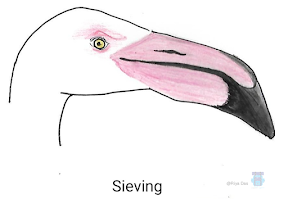What is bill or beak?
The bill of birds, also known as the beak, is
the most critical anatomical structured part of their body. It is not just for
gathering food, it is a multifunctional tool. They can be used for grooming,
fighting, courtship display, feeding young, nest-building, manipulating objects
and even regulating temperature. By studying their bill, we can learn about the
age, gender, diet and foraging behavior. Birders also use bill or beak shape,
size and color for proper identification of birds.
Following features
are of immense importance when studying bird bills :
·
Size of the bill –
Different birds have varied sizes of bills. The length as well as the width of
the bill helps in easy identification of the bird.
·
Shape of the bill –
The shape of bird’s bill vary widely, such as, thin bills, needle-like bills,
thick bills, sharply curved bills, spoon-like bills, sword-like bills and many
more. The shape of a bird’s bill is a very important identification tool for
the birders.
·
Colour of the bill –
The colour of a bird’s bill indicates its species, gender, age and is used for
identification by birders.
Different bill
parts:
1. Lores: It is the area between the eye and bill on the side of
birds head, which is sometimes featherless and the skin may be colored or show
a smudge or eye line that can be identification clue.
2. Nares: Bird nares are essentially bird nostrils. The nares
are two holes – circular, oval or slit-like in shape – which lead to nasal
cavities within the bird’s skull. In raptors, the nares are covered by a fleshy
cere and in seabirds, elongated tube-like nares help filter seawater.
3. Maxilla: It is the top half of a bird’s bill, also called the
upper mandible. Some birds have knobs, wattles and other different features
which distinguish the maxilla.
4. Culmen: It is the upper ridge of bird’s beak. The shape and
coloration of the culmen is useful field mark for the identification of some
bird species.
5. Tip: The tip of bird’s bill may be different types, depending
on the bird’s food habit.
6. Nail: End of the bill.
7. Mandible: Lower part of the bill is called mandible. Color
may vary from maxilla and it can be useful field mark for the identification of
some bird species.
8. Chin: It is the feathered part below the bill ending where
throat begins. It is also useful field
identification mark of some bird species.
9. Gape: The area where base of the bill join the face.
10. Gonys: The lower part of the lower mandible.
11. Rictal bristles: Row of bristly feathers directed outward
from the gape along the edge of the maxilla or sometimes mandible, which is
morphologically similar to mammalian whiskers.
















